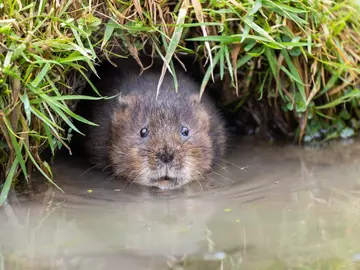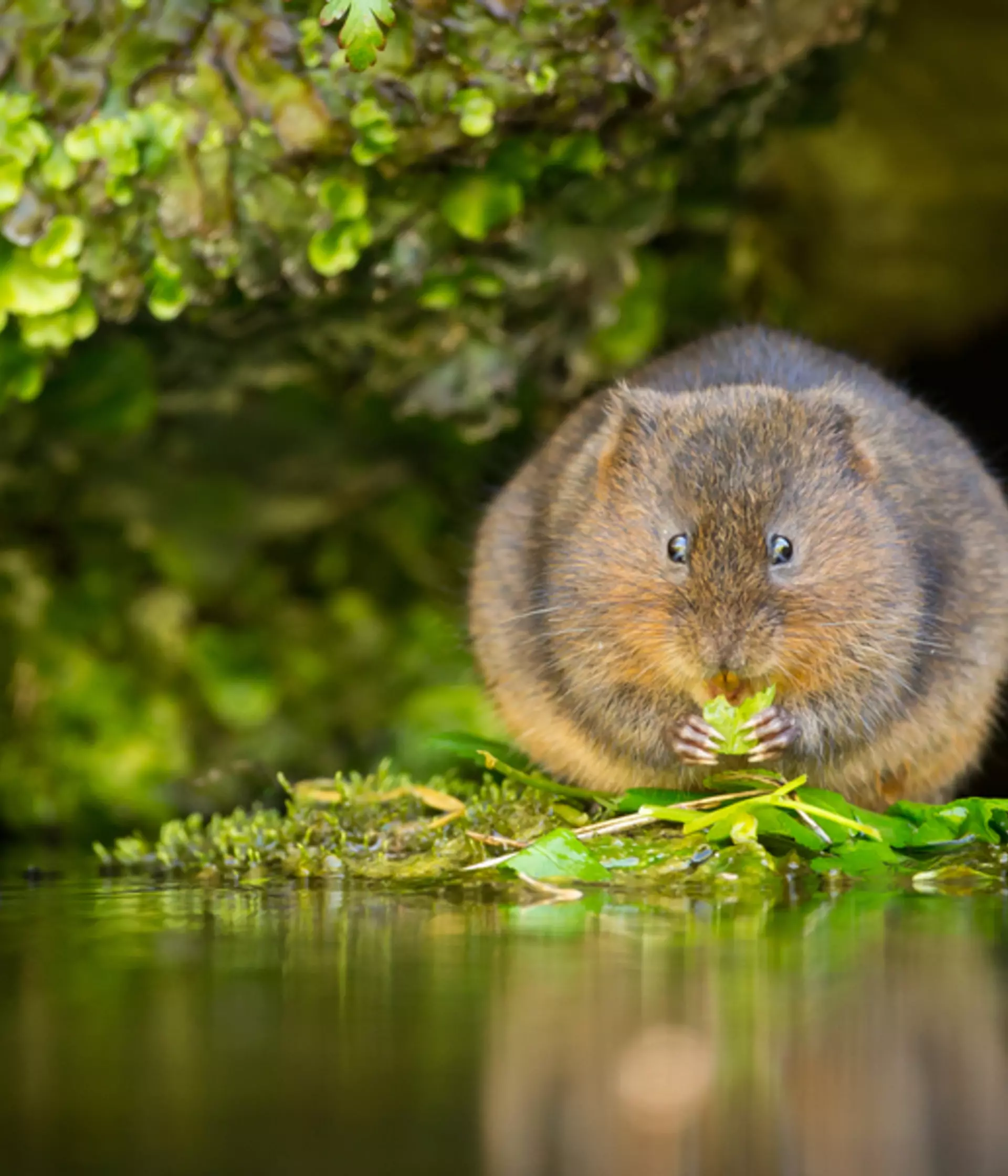
UK water voles
Water voles are the UK's largest vole, around the size of a small guinea pig. Their coat colour varies across the UK, a reddish/brown coat in England, with darker brown/black variations in Scotland. They were once Britain's fastest declining mammal and are still under threat from American mink, a non-native predator that was introduced to the UK in the 1920s. We're leading a collaborative water vole recovery programme in London.
The London Water Vole Recovery Programme
The London Water Vole Recovery Programme was created with the aim of restoring water voles to the capital, an area where they once thrived.
Phase one of London Water Vole Recovery Programme for 2023 and 2024 is a partnership with People's Trust for Endangered Species, Greenspace Information for Greater London, London Wildlife Trust and supported by the Mayor of London.
The current focus of the project is to build a clear picture of where remnant populations of water vole may persist, so that future conservation activities can be better informed. For this we need your help.

Support water vole conservation
Report a water vole sighting
Play your part in restoring water vole populations in London by helping us better understand their current distribution. Please record sightings of water voles or American mink in Greater London, so that we have the as much information as possible to help us aid their recovery.
Join/Register a site to survey water voles
People’s Trust for Endangered Species run the annual National Water Vole Monitoring Programme, to try to understand where water vole remain and how many there are. Currently only a few survey sites exist within Greater London and we are looking to help expand this number. For more information on how to join or set up a water vole survey site.
London Water Vole Recovery Programme Working Group
We chair the London Water Vole Recovery Programme Working Group, a pan London collaboration of fellow conservation NGOs, Local Authorities and landowners.
Water vole habitat
Water voles live along slow-flowing rivers, streams, ponds, lakes, canals and reedbeds, preferably with a water depth over 1 meter. They prefer water bodies with large swathes of vegetation, emerging from both the riverbank and the water itself. As they create burrows inside sheltered, steep banks of 45 degrees or more, they have an affinity for soft, easily penetrable earth.

Some water vole colonies are fossorial, meaning they are grassland based and live in underground burrows. This is common in mainland Europe, where they can be found in high numbers and are even considered pests in some areas. Some fossorial water vole colonies exist in Scotland.

Ecosystem engineers
Water voles are ecosystem engineers as their population dynamics, feeding and burrowing behaviour can influence their environment and effect plant diversity. Feeding on the roots and shoots, water voles can prevent a single plant species from becoming dominant and can help with seed and rhizome dispersal. Their burrowing can also alter the soils moisture levels, biological properties and microbial activities, which in turn regulates the availability of nutrients for plant growth. Studies suggest that with the declines of water voles, plant communities will become less diverse which will result in biodiversity loss.
Protecting London's water voles
Get involved with London Water Vole conservation
Watch to find out how you can get involved in our new collaborative London Water Vole Recovery Project.
What do water voles eat?
Water voles are herbivorous, with 227 plants recorded at feeding sites. During pregnancy, the females have been known to supplement their diet with flowers, for their protein rich pollen and sometimes even eat molluscs, snails and small fish.
Water vole lifecycle
Water vole populations boom in the summer, females can have 3-5 litters between March and September, with up to five young per litter. Life expectancy in the wild is just 5 months on average, due to the high predation rates of juveniles, often occurring when they are dispersing. In some colonies over winter mortality can be very high, up to a 70% decline and most individuals won’t survive more than two winters. Water voles do not hibernate but can spend a long time in their nesting burrows during the colder winter months.
British native water vole predators
In a healthy ecosystem, water voles are an important food source for all kinds of British wildlife, including foxes, otters, stoats, weasels, owls, herons, marsh harriers, and pike. Their high breeding rate and natural predator avoidance mean that water voles can persist in these natural systems.
How to identify water voles in the UK
Water vole droppings
Water vole droppings are oval, dark brown to green and completely odourless. They can be distinguished from rat droppings by their shape, as rat droppings have pointed ends. They often latrine on objects that protrude from the water like rocks and sandbags.
Water vole feeding signs
Water voles make feeding stations along the banks and leave behind neat piles of chewed vegetation. Stalks and stems that they eat are left behind with 45-degree cuts to their ends.
Water vole or rat?
Water voles will enter the water when startled, unlike rats which usually dash into vegetation. Water voles have small rounded fluffy ears with blunt brown noses with a short furry tail. Rats in comparison have a much longer tail, pink pointy ears and nose without fur.
Waters voles are very buoyant and fast swimmers, they make a 'plop' sound when enter the water and look like a small rugby ball floating through the water. On ground, they often sit on haunches, munching vegetation or grooming.
Water vole burrows lead into the water and have a nibbled lawn around their entrance. In comparison, rat burrows lead away from the water generally and are clear of vegetation. Rat burrows also have spoil scattered around and are well worn between holes, with a smell of ammonia and droppings scattered along runs, whereas water vole burrows are neater and their droppings will be in piles.
Water vole predators
American mink and water voles
American mink are a medium-sized member of the weasel family. A non-native predator, they originally escaped or were released from fur farms in the 1920s. American mink are very successful predators of water voles; female mink can enter the burrow of a water vole to catch them, making natural water vole predator avoidance behaviour useless. Mink also predate on many other native species like nesting birds, fish and amphibians.

Over the years, American mink populations have increased and they are now common and widespread throughout the UK.
Studies have shown that lots of water vole populations have been lost due to the presence of American mink, when previously the habitat had supported large, stable populations. Mink can travel 20-40 km within a short period of time, meaning no water vole colonies are immune from the threat of mink.
Identifying American mink
American mink are very illusive and are most active at dawn and dusk. They are ferret like in appearance and movement, similar to polecats and pine martens. American mink have a distinctive white patch under their chin, and their tracks usually follow the soft edge of a water body and are easy to spot. They have five toes which radiate from a crescent-shaped central pad which can be seen in soft mud, while on harder surfaces their tracks might only show four visible toes. Their paw size will be around 3cm-4cm wide, similar to cat footprints.
